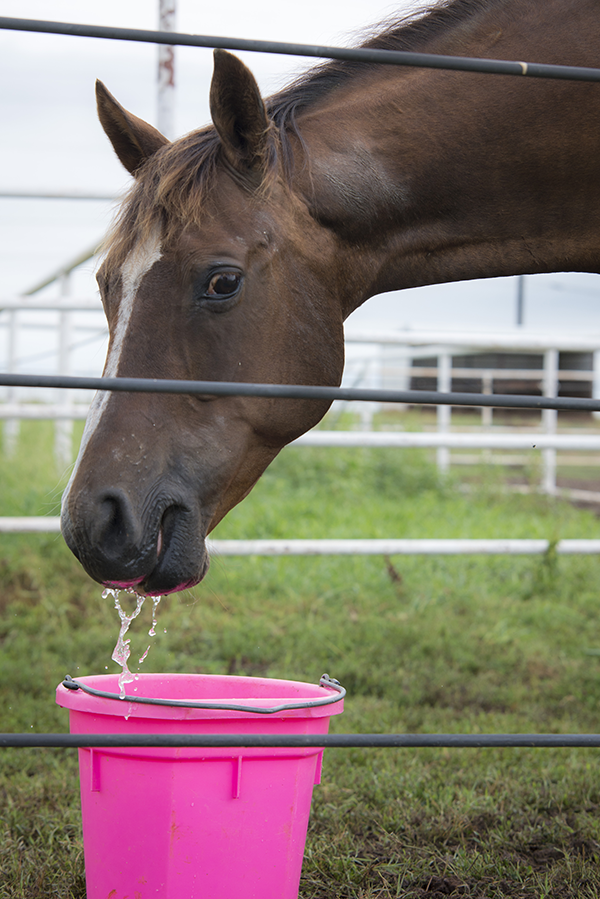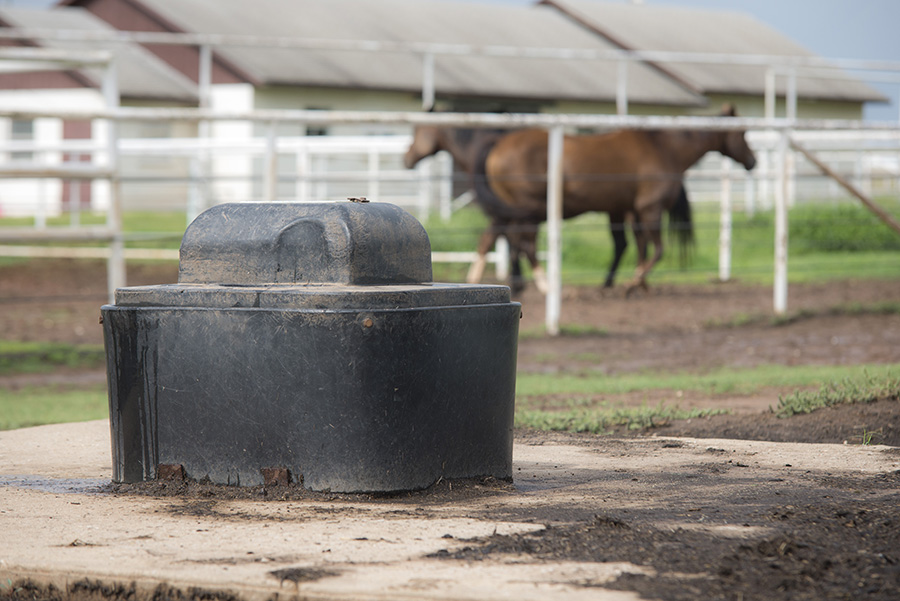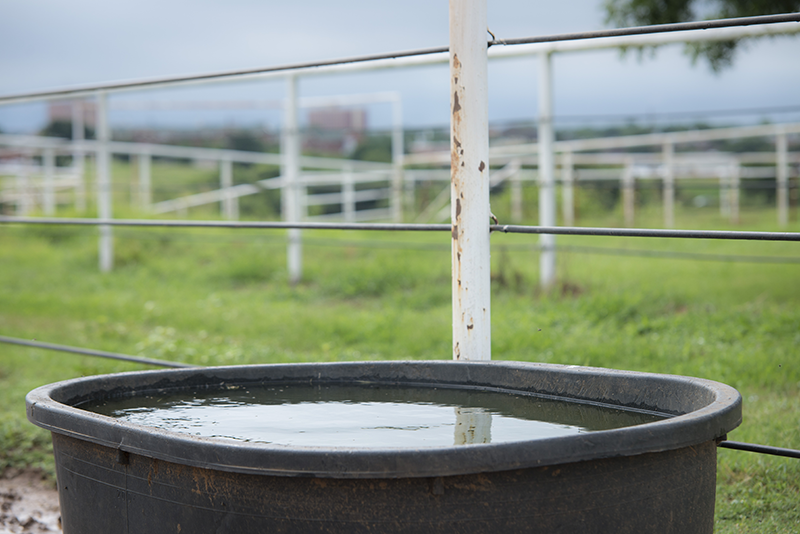Optimizing Water Intake
- Jump To:
- References
To ensure adequate water intake by the horse, the manner in which water is provided should be considered. Horses naturally drink water out of streams, ponds, etc., but modern management systems are often quite different. Owners may choose between troughs, tanks, buckets or automatic waterers, depending on their management scenario. Automatic waterers may be massive time savers for people, but what do horses actually prefer? Many horsemen may think horses enjoy drinking from buckets far more than automatic waterers. This has actually been borne out in the scientific literature. Given a choice, horses used buckets in preference to automatic waterers almost exclusively. The type of waterer may also influence a horse’s drinking behavior. In a study of horses never exposed to automatic waterers, horses preferred float valve waterers compared to push valves. Push valve waterers are those in which a horse must use some force of its muzzle against the valve. In that study, horses never consumed water from the push valves at all. It was believed the larger available reservoir of water in the float waterers encouraged the horses to drink more. In addition, push valves have a somewhat startling effect of the noise of water refilling the waterer and horses were reluctant to return to the waterer after being startled.

In addition, the normal intake rate of water by a horse actually exceeds the flow rate of most waterers. Therefore a horse would need to drink much more often when using a low flow waterer. This may actually cause the horse to reduce its intake compared to being offered bucketed water. This does not mean that automatic waterers should not be used. When selecting a waterer, look for one that maintains a larger reservoir of water or has larger surface area. Try to find a quiet waterer as well. Certainly horses can learn to use push valve waterers, but during the training period, careful observation should be employed to prevent dehydration. It may also be helpful to install a monitoring system in the pipeline feeding the waterer so consumption can be monitored.
Traveling with horses is also a key time to closely monitor water intake. Horses may reduce water intake for many reasons when being hauled for long distances. Stress, unfamiliar flavors of water, reduced feed intake and increased water losses may all create a state of dehydration. During travel, horses often will reduce their feed intake, which subsequently reduces water intake. Remember that feed intake and water consumption are linked closely together. Reduction of water intake may lead to dehydration as horses typically increase water losses through sweating while hauled. Owners often fail to consider how much muscular work a horse must perform to balance on long trips. Reduction of water availability may decrease a horse’s desire to eat as well. Thus, proper water and feed intake are a must for traveling horses. It is important to break this cycle of reduced feed and water intake to ensure a healthy happy horse when it reaches its final destination. In general, if total travel time will be more than 5 hours, try to stop every 3 hours to allow the horse a 15- to 30-minute rest. Offer hay and water during these times.
Horses in new environments may also be reluctant to consume water with an unfamiliar flavor. Addition of a flavoring agent may accustom a horse to a unique flavor, which can mask new tastes. However, it is important to introduce the flavoring agent at home. Horses accept new flavors more readily when they are not stressed and in their home environment. Use a training period prior to travel so that the horse is not discouraged from drinking. In a test between apple and clover flavors, horses clearly preferred apple-flavored water. There are multiple products available, so choose one your horse likes.

Horses also drink when they eat, so it is important to offer water simultaneously with feeding. Some horses may prefer dipping their hay in water. This is a normal behavior and need not be discouraged. While it may be messy, horses may do this to moisten their dry feed and make it easier to chew. In recent studies, horses consumed their hay much faster when it had been previously soaked. Presumably this was due to the ease of chewing of the soaked hay. This strategy may be helpful for horses with dental issues.
Ultimately, the total amount of forage dry matter consumed will directly influence water intake. Therefore, the amount of moisture present in feed will change water intake. Horses grazing fresh pasture grass, which can reach 80 percent moisture content, can supply a large proportion of their water intake through grass consumption. Expect that water tanks and buckets may not be emptied as quickly when horses are grazing. Even so, a constant supply of clean fresh water is a must.

Horses are also sensitive to the temperature of their water. In a study examining temperature choices following exercise, horses initially preferred a cooler water source, however, 20 minutes after exercise, they preferred lukewarm water. Presumably the horses preferred the cooler liquid initially in order to help with thermoregulation. Season also affects water consumption. During cold weather, horses reduce their water intake compared to more moderate temperatures. Therefore it is much easier for horses to become dehydrated in the winter, especially if their access to water is limited by ice formation. Horses prefer to drink water that is luke-warm compared to icy cold. Offering only icy water in winter can easily cause dehydration and potentially lead to colic. Geriatric horses may also be more susceptible to dehydration in winter as icy water may irritate their teeth. Therefore providing a tank or bucket heater is an important step in health management in the winter. Additionally, adding salt to the diet of the horse compared to offering only a free choice salt block may encourage water intake during cold temperatures. Try mixing an ounce of salt into the concentrate portion or other palatable feed source. Other solutions to encourage water intake during cold weather include adding water to either pelleted feeds or creating bran mashes. In one study, horses fed a mash actually consumed more water voluntarily than horses that were fed a dry concentrate.
While you may lead the horse to water, and it may not drink; it helps to have a source of water the horse actually prefers! Following these simple strategies can help ensure your horse is always well hydrated.
References
L.A. Mars, MS, H.E. Kiesling, PhD, T.T. Ross, PhD, J.B. Armstrong, PhD, L. Murray, PhD. Water acceptance and intake in horses under shipping stress. Journal of Equine Veterinary Science 12(1):17-20
Prawit Butudoma, Donna J. Barnesa, Matthew W. Davisa, Brian D. Nielsenb, Susan W. Eberharta, Harold C. Schott IIa, Rehydration fluid temperature affects voluntary drinking in horses dehydrated by furosemide administration and endurance exercise. The Veterinary Journal. 167(1):72-80.
S. Nyham and K. Dahlborn. Effect of water supply method and flow rate on drinking behavior and fluid balance in horses. Physiology and Behavior 73(1-2):1-8
Kris Hiney
Extension Equine Specialist
